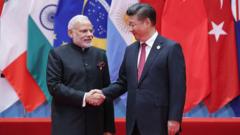The Indian hair market thrives on the export of hair collected by pickers, often seen as waste, but is now being embraced for its potential in wig production. As social norms shift towards acceptance, local businesses like Diva Divine Hair are rising to meet the growing demand for wigs, while industry experts advocate for more investment in India’s value chain to compete globally.
The Hidden Value of Indian Hair: Transforming Waste into Glamour

The Hidden Value of Indian Hair: Transforming Waste into Glamour
India, the world's largest exporter of human hair, is witnessing a revolution as wigs evolve from a niche market into a fashionable statement, with untapped potential for local production.
Zeeshan Ali, a Mumbai-based drag artist with over a decade of experience, shares how his collection of 45 wigs is central to his performances, transforming him into various vibrant characters. “The right wig makes me feel more authentic,” he states, highlighting the empowerment it brings during his shows. However, he notes that accessibility to quality wigs was a struggle in his early career when they mostly had to be imported or fashioned from alternative materials.
Today, the perception of wigs in India is changing significantly. No longer relegated to the realm of drag or film, wigs are now a fashionable accessory embraced by women seeking a new look. Indian human hair, in particular, has become a prized asset as the country stands as the largest supplier, accounting for 85% of global demand.
Kolachi Venkatesh, a hair collector from Chennai with 20 years of experience, explains that hair is often collected from households and salons as "non-Remy" hair, traditionally discarded but possessing great potential value. He remarks, “It’s just thrown away but it’s gold.” While individual pickers earn meager wages for their efforts—ranging from 59 cents to $6 per day—Venkatesh employs 50 workers to gather hair, contributing to a billion-dollar market.
Most of this hair ends up in China, where a booming wig-making industry reaps the rewards, trading in a market worth five to six billion dollars. Benjamin Cherian from Plexconcil, an industry body advocating for Indian stakeholders, stresses the need for India to bolster its production capabilities. “We need to promote investment in the hair industry,” he states. Emphasizing that India should focus on value addition rather than simply exporting raw hair, he mentions that innovative practices must be implemented to compete effectively.
Diva Divine Hair, co-founded by Nidhi Tiwari in 2009, reflects a change in attitudes towards wigs and hair extensions, which are now more widely accepted than in the past. The company capitalizes on rising hair loss issues among women, offering advanced technologies that enhance comfort and personalization, including 3D-printed wigs and digital color-matching tools.
As demand for Indian hair surges, the market is diversifying. High-value "Remy" hair, mainly sourced from temples in southern India, showcases processes that ensure quality. George Cherion of Raj Hair International highlights their commitment to minimizing waste with innovative techniques and machinery, resulting in faster production and higher quality.
Despite the booming global market, Zeeshan Ali urges for advancements in local wig production. He dreams of seeing wigs that combine affordability with aesthetic appeal capable of making a powerful statement, showcasing the vast potential still waiting to be unlocked in India’s hair industry.



















